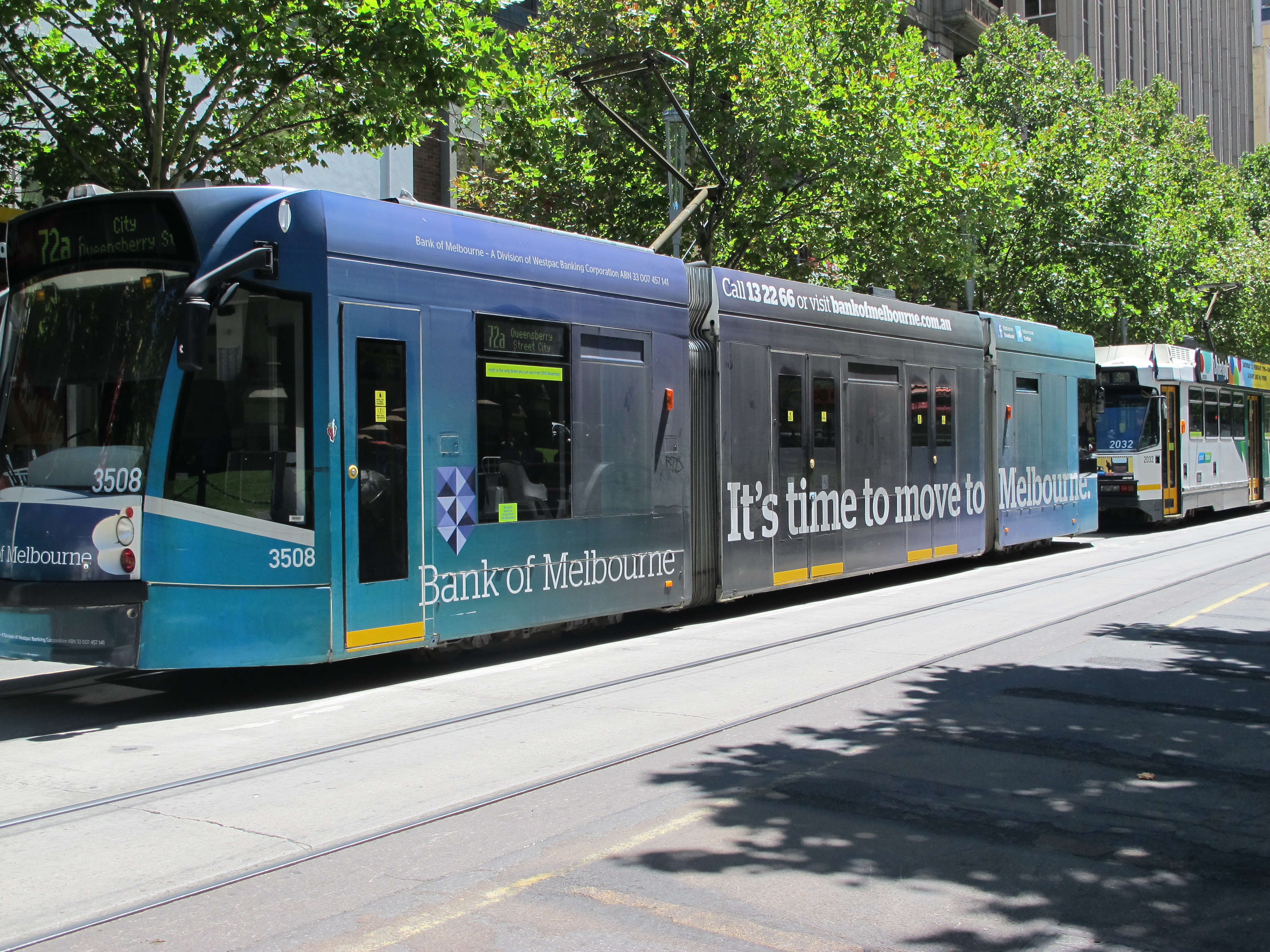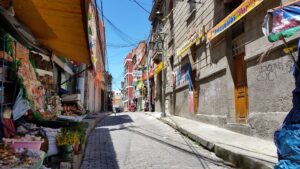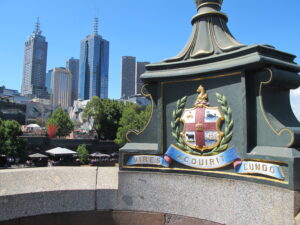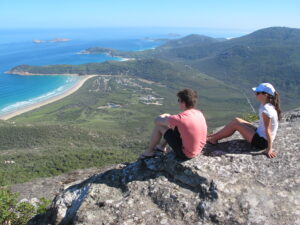In January, we uprooted ourselves from Wellington (see The Move, Part 1); here’s what it took to replant ourselves in Australia.

It’s time to move to Melbourne, as the tram says.
We had become quite familiar with Wellington and how things work in New Zealand. For Australia, and Melbourne, we had several new things to learn: specifically about visas, banking and insurance, as well as finding a place to live and settling into it.
Visa
It’s actually very, very easy to get a visa in Australia for longer stays. For New Zealand, we had to fill out a paper application, send it to a consulate with various recommendations and our passports…and then wait. In Australia, we completed an online application in October and within two days had our electronic visa, virtually stamped and floating somewhere in the cloud.
The one year visa (from date of application) allowed for multiple entries/exits through October 31 of 2013, then six months more as long as we don’t leave the country. In effect, that meant just a nine month visa from our arrival in January. We never know when we might need to visit the U.S. for family matters, say in November, and wouldn’t want to be blocked from returning for our things.
Money matters: Banking

In theory, you could do without a local bank account; in practice, it’s hard to avoid one. Most rental agencies require you pay rent via a direct debit from your bank account. Also, if you have an account, you get the EFTPOS card (cash/debit card) which is just about universally accepted here, so you don’t need to carry bits of cash around. We do use a credit card that incurs no foreign transaction fees; that gives us the absolute best currency conversion rate. But for small purchases, the EFTPOS card is your friend.
Anyway it’s not difficult to get an account. Most banks let you sign up before you arrive, and deposit funds via wire as well. You can’t use the account until you arrive and complete the modest paperwork at a branch, but that takes less than an hour.
The complication in Australia is the long arm of the tax collector. When we spoke with the Australia Tax Office (ATO) or IRS equivalent and when we spoke with the bank, opinions differed on what our non-resident status implied regarding taxing of our interest income (at about 4%)…
Bank: You may have to pay a mandatory withholding of about 50% of interest.
Taxman: You don’t need a tax number, but will have to pay 10% anyway, the percent the bank would withhold if you change your primary address to be outside Australia.
Bank: No, you wouldn’t owe anything if you did get an ATO number, but you might have to file a tax return.
Us: Oogh. The 10% is worth paying to avoid any more hassle.
Money matters: Insurance
So far we’ve not found any global property protection against fire, theft, etc., so we needed to get contents insurance here just as we did in New Zealand. We quizzed our friends and screened reviews of local providers, all but three of which had ridiculously low ratings. You can even get property insurance from your bank, but there’s no apparent advantage to that, especially if their source has one of those low ratings. Our quick favorite was the RACV, the local auto club, and we eventually worked through the details with them.
Interestingly, contents insurance always comes with a liability policy, in case someone is injured or worse on your property, for up to $20 million. In the U.S., you have to buy an umbrella policy to supplement your basic plan, but not here. But even more perplexing was insurance if you drive a car. We don’t own one, but couldn’t figure out how people protected themselves from asset-threatening lawsuits if they drove a rental car, say. It turns out, that, in Australia, the car is responsible for its own driving – at least from the perspective of insurance. Car registration pays, by law, for unlimited liability for injury to a person (compulsory third party) in a no fault coverage. All rental cars come with unlimited liability for damage to others’ property (third party property) as well. All you need to worry about with rental cars is covering damage to the car itself.
Hearth and Home: Finding a Place

We’ve rented many, many apartments and homes unseen except via photos on the internet, most recently in New Zealand, but in many other places during our travels. For short term stays, we’ve done the same in Australia too.
But longer rentals are a different beast, a system designed for locals rather than nomads like us. In Australia, you must search each agency on your own (or through a partial consolidated listing site); no one in an agency can assist you with the properties managed by another agency. Most of the rentals, furthermore, don’t become public till a month before they’re vacated. Worse yet, agencies require that you actually view the apartment before renting, presumably because you can’t say you weren’t aware of something in the place after signing a contract.
With all these obstacles, our first thought was to find a temporary place for, say, two weeks. During those weeks, we would look for a more permanent place. Lots of advantages there because you see what you get; on the other hand, you do two moves and not one. Our next thought was to fly to Australia, but the $500 cost to do this seemed a bit much. Our third thought was blank until, in December, a good friend in Melbourne offered to view a few viable places that had shown up in the listings. She did so, and one of the four she saw passed her inspection. We’re in that one right now.
Once you’ve found the place, there’s all the paperwork to send back and forth, which we did via email and the virtually free faxing service called HelloFax, available via Google Drive. Then, typically, we would wire some money for the bond and initial weeks. Our agent, however, kept insisting we do a direct debit from a local account we did not have yet. Approving receipt of a wire had to come from several levels of management up. They had their money on time that way, but perhaps they were right after all, as their bank eventually charged them $20 in fees.
Hearth and Home: Utilities
Setting up the utilities was relatively easy. Rental agents use a service free to renters called ConnectNow. With one call to them, you can sign up for electric, gas, water, sewer, internet – way before you arrive. Other than the service’s strange resistance to sending us a confirming email, all went without a hitch – except for the internet.
The internet company did contact us quickly, but had their own idea of timing, claiming that it could take up to 20 business days to get service – a month from arrival. Our research showed that other providers took as long, so we had little choice but to plan on a lot of trips to nearby sites for free wifi, or the next door Starbucks for the price of a cappuccino. Instead, however, we decided to get a wifi hotspot on Telstra’s superfast 4G network. As it turned out, we had regular internet service within 10 business days, but will definitely use the hotspot again when the next internet company tells us they need 20 days to get service going.
Hearth and Home: Move-In

The arrival in Melbourne was rather easier than expected despite the awkwardness of two people trying to maneuver three overloaded carts through the customs gatekeepers. We were fortunate that a good friend in Melbourne had obtained our keys from the real estate agent and then picked us up at the airport, barely stuffing all the bags into his Range Rover. He delivered us rapidly to our door where friendly neighbors helped us port the bags up a level to the elevator. Greeted by a clean and well equipped apartment, with the required utilities all humming, we even felt good enough to unpack most of the bags before retiring.
The next morning, we finished the paperwork in an hour, then easily arranged for our new SIM chips and phone numbers from the local Telstra store along with the hotspot (a choice we made in advance from friends’ recommendations and reviews).
But there was one more chore. On signing, we were handed two documents. First, a thorough 10 page condition report detailing the wondrous state of the apartment walls, floors, rugs, etc. – along with 216 glossy color photos (“with writing on the back”?). Second, another 10 page chattels report which itemized the contents of the apartment – the knives, cups, spoons, beds, chairs and, oh yes, the roll of sticky tape. We expected elaborate reports like this from our experience in Wellington. They’ve become a standard procedure now to protect the property owners’ from destruction and pillage. And somewhat warranted, we discovered, as a previous tenant had left this apartment in need of $10,000 of repair. Back in Dallas, a previous tenant had wrecked many items and savagely gouged the old hardwood floors before we moved in.
OK, we get it, but we don’t want to be blamed for minor scuffs and such when the report describes the floors as “like new.” So we counted all the knives, cups (making fine distinctions about what constituted one color Japanese tea cup from another), spoons, bed, chairs, plus the 1 roll of sticky tape. And we took a few hours documenting all the imperfections, like a home assessor hired to scrutinize each flaw in a house when you sell. To quote Robert Shaw in Jaws about bringing the shark to a taxidermist, “He gonna have a heart attack when he see what I brung him.” You have to protect yourself too.
Over the next week, as was also true in Wellington, we found we needed to supplement kitchen implements a bit. This one had just one fry pan, and we have found two are pretty useful to us. We needed plastic storage containers for leftovers. We needed a few good knives. Those led us to find the hardware store and Target store nearby.
Also, in a biking-friendly town like Melbourne, we decided to buy some inexpensive bikes. We needed to add a cheap desk to make our second bedroom an office; we found one at Officeworks for even less than the nearby Ikea (assembly still required). We stocked up on produce at the Queen Victoria Market, while locating two grocery stores within minutes of us for other necessities. We even found a few funky bars nearby to sit out and enjoy a bit of summer.
In short, we had arrived.
(Also, for more pictures from Australia, CLICK HERE to view the slideshow at the end of the Australia itinerary page.)






